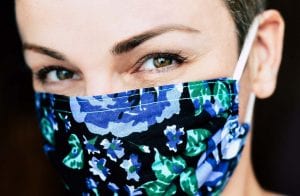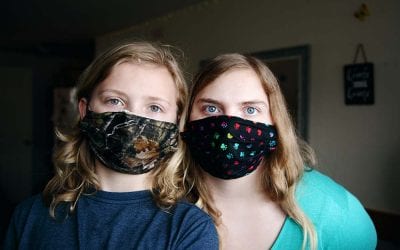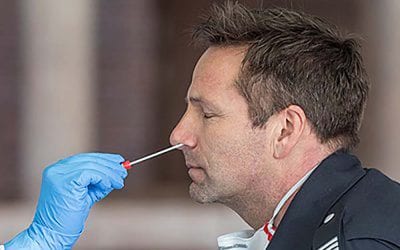COVID-19 has decreased, but the pandemic isn’t over.

When we had similar case counts and mortality statistics in 2021, mask mandates across the nation remained. Many are unsure if mandates are being dropped because it’s actually safe to be in concert halls, movie theaters, restaurants, hotels, and other venues or if they are being dropped for political purposes.
Travelers must assess their vulnerability to COVID according to their age, health, location, and activity, then wear a face mask as warranted to protect themselves against contracting COVID.
Perform a risk-benefit analysis of your situation to determine when you should wear a face mask.
Travelers need to do a risk-benefit analysis to determine if they need to wear a face mask during their journey. The analysis must include their personal COVID vulnerability and the COVID situation at their destination. Travelers must assess the situation along their journey, plus the COVID risk of the activities in which they will participate..
The more COVID vulnerable you are, the more important it is for you to wear a face mask in riskier situations.
Unvaccinated vs. vaccinated:
We’ve learned from COVID data analysis that fully vaccinated and boosted individuals can become infected with COVID-19. The vaccine is extremely effective in preventing serious cases of the virus that require hospitalization and/or cause death.
We also know that age is an important factor in COVID vulnerability. According to the data, as we get older, if we’re infected with COVID, we’re more likely to get a serious case and possibly die from it.
Statistics show that COVID vaccines are extremely effective in preventing serious COVID illness and death.
Statistics gathered by the Washington State Department of Health (WSDH) can help travelers understand the importance of being vaccinated within major age groups. According to WSDH:
• Unvaccinated 12–64-year-olds are 3 times more likely to get COVID-19 and 5–6 times more likely to be hospitalized with COVID-19 than vaccinated people in this age group.
• Unvaccinated 65-year-olds and up are 4 times more likely to get COVID-19, 7 times more likely to be hospitalized with COVID and 7 times more likely to die from COVID-19 than vaccinated people in this age group.
Vaccination is crucial for everyone, especially senior citizens.
Consider Long Covid issues when deciding whether or not to wear a mask.
When assessing the risk of COVID, travelers can’t forget “Long COVID.” It’s when COVID survivors continue to suffer from at least one of its symptoms for months and months. Some Long COVID patients can function through their illness, but others continue to be so sick that they are unable to work and need substantial, regular medical care.
The American Academy of Physical Medicine and Rehabilitation estimates that 23.5 million Americans are suffering the misery that Long COVID brings. That’s an astounding seven percent of the U.S. population. Many of those cases could likely have been avoided had more Americans been vaccinated.
Sometimes, even outdoor concerts are risky to attend without wearing a face mask.
Outdoor location vulnerability:
If you’re outdoors in parks, along sidewalks and in other open outdoor locations, unless you’re within a tightly packed crowd of people, it’s unlikely that you have a significant risk of contracting COVID. On the other hand, even when outside at a concert or sports venue, for example, if you’re sitting or standing shoulder to shoulder with others, the crowd density substantially raises your risk of becoming infected. If you can’t feel air movement, then your risk is increased.
At a rock concert, for example, if many are singing with the band, as often happens, the risk is raised even higher as there’s considerable saliva/spit (respiratory droplets) being expelled forcefully out of everyone’s mouths who are singing.
Hotel gyms are among the riskiest locations where travelers can become infected with COVID-19.
Indoor location vulnerability:
When inside, your risk of contracting COVID is inherently higher than when you’re outside. There is less air to dilute any virus around you. Assess the space you enter to determine the risk. Are the ceilings high? Is the air moving? Are the people there tightly packed? Is there a reasonable amount of personal space? Does the space have high-quality air filtration? At a restaurant, are the tables “on top of each other?”
Gyms, particularly hotel gyms, tend to be small with poor ventilation. Remember that most people are breathing more heavily than normal due to exercising. That causes a significant risk, especially if anyone in the gym isn’t wearing a mask.
Chronic disease and compromised immunity:
For travelers with compromised immunity or chronic illnesses such as heart or lung disease, precautions, including wearing a quality face mask at most locations, is essential.
Planes, trains, buses, depots, stations, airports:
Public transportation is often risky these days, particularly at times when locals are commuting or crowds are traveling to particular events. Often, mass transit, its stations, depots and vehicles, have poor ventilation. On airplanes, we know the ventilation is excellent while the plane is aloft, but while on the ground, particularly at the gate, the ventilation is either off completely or not fully running. If the plane is crowded, your risk may be high despite the ventilation, because so many people are sitting very near you.
Always determine the COVID situation at your destination before leaving on your trip.
Destination:
Most of us know what the COVID situation is at home, but when traveling it’s essential to know what’s happening with COVID at our destination and along the way during our journey. We need to understand the risks.
Traveling companions:
Compared to other risks, the risk of COVID is likely highest from your traveling companions, whether it’s family, friends or a travel group. Typically, you’re physically close to them. That means if they have COVID, you’re very vulnerable due to your proximity to them and the amount of time you’re spending with them. If your traveling companions are more vulnerable than you, wear a face mask for their protection alone.
If you’re not vaccinated you’re highly vulnerable to becoming infected with COVID-19. Unless you’re in a wide open space while traveling, wear a mask.
Sometimes even young, healthy, fully vaccinated and boosted travelers should wear a face mask.
Those who are fully vaccinated and boosted, young and healthy are at less risk than others from becoming infected with COVID, no matter what the situation. Yet, I recommend that you should wear a mask in highly crowded indoor spaces and even outside according to the situation, while riding mass transit or elsewhere if you assess significant site or activity risk.
Even if you’re fully vaccinated and boosted, older travelers and those who have chronic health issues such as heart or lung disease or are immunocompromised should wear a face mask whenever in tight, cramped indoor spaces and even in crowded outdoor spaces. Wear a face mask on public transportation, on airplanes and at airports, public areas of hotels, etc. In good weather, eat outside at restaurants to reduce your risk.
Wear a face mask that will actually protect you.
Whenever wearing a face mask, only wear an N95, KN95 or KF94 mask because they are effective. Even surgical masks don’t give the same high quality protection as the others. Masks with air valves and cloth masks offer minimal protection.
Whenever you suspect the risk of COVID infection is elevated, wear a face mask. It’s better than being infected with COVID.
After many years working in corporate America as a chemical engineer, executive and eventually CFO of a multinational manufacturer, Ned founded a tech consulting company and later restarted NSL Photography, his photography business. Before entering the corporate world, Ned worked as a Public Health Engineer for the Philadelphia Department of Public Health. As a well known corporate, travel and wildlife photographer, Ned travels the world writing about travel and photography, as well as running photography workshops, seminars and photowalks. Visit Ned’s Photography Blog and Galleries.



